TP-LINK TL-WR820N Manual

User Guide
300Mbps Wi-Fi Router TL-WR820N
REV1.1.0 1910012684
Contents
About This Guide . . . . . . . . . . . . . . . . . . . . . . . . . . . . . . . . . . . . . . . . . . . . . . . . . . . . . 1
Chapter 1. Get to Know About Your Router . . . . . . . . . . . . . . . . . . . . . . . . . . . 2
1. 1. Product Overview . . . . . . . . . . . . . . . . . . . . . . . . . . . . . . . . . . . . . . . . . . . . . . . . . . . . . . . . . . . .3 1. 2. Panel Layout . . . . . . . . . . . . . . . . . . . . . . . . . . . . . . . . . . . . . . . . . . . . . . . . . . . . . . . . . . . . . . . . .3 1. 2. 1.Top Panel . . . . . . . . . . . . . . . . . . . . . . . . . . . . . . . . . . . . . . . . . . . . . . . . . . . . . . . . . . . . . .3 1. 2. 2.Back Panel. . . . . . . . . . . . . . . . . . . . . . . . . . . . . . . . . . . . . . . . . . . . . . . . . . . . . . . . . . . . .4
Chapter 2. Quick Setup . . . . . . . . . . . . . . . . . . . . . . . . . . . . . . . . . . . . . . . . . . . . . . 6
2. 1. Position Your Router. . . . . . . . . . . . . . . . . . . . . . . . . . . . . . . . . . . . . . . . . . . . . . . . . . . . . . . . . .7
2. 2. Connect the Hardware . . . . . . . . . . . . . . . . . . . . . . . . . . . . . . . . . . . . . . . . . . . . . . . . . . . . . . .7
2. 3. Set Up the Router . . . . . . . . . . . . . . . . . . . . . . . . . . . . . . . . . . . . . . . . . . . . . . . . . . . . . . . . . . . .8
Chapter 3. Log In to the Router . . . . . . . . . . . . . . . . . . . . . . . . . . . . . . . . . . . . . 10
Chapter 4. Configure the Router . . . . . . . . . . . . . . . . . . . . . . . . . . . . . . . . . . . . 12
4. 1. Device . . . . . . . . . . . . . . . . . . . . . . . . . . . . . . . . . . . . . . . . . . . . . . . . . . . . . . . . . . . . . . . . . . . . . 13 4. 2. Network. . . . . . . . . . . . . . . . . . . . . . . . . . . . . . . . . . . . . . . . . . . . . . . . . . . . . . . . . . . . . . . . . . . . 13 4. 2. 1.WAN Settings. . . . . . . . . . . . . . . . . . . . . . . . . . . . . . . . . . . . . . . . . . . . . . . . . . . . . . . . 13 4. 2. 2.LAN Settings . . . . . . . . . . . . . . . . . . . . . . . . . . . . . . . . . . . . . . . . . . . . . . . . . . . . . . . . 25 4. 2. 3. IPv6 . . . . . . . . . . . . . . . . . . . . . . . . . . . . . . . . . . . . . . . . . . . . . . . . . . . . . . . . . . . . . . . 26 4. 2. 4. IPTV . . . . . . . . . . . . . . . . . . . . . . . . . . . . . . . . . . . . . . . . . . . . . . . . . . . . . . . . . . . . . . . 28 4. 2. 5.MAC Address Settings. . . . . . . . . . . . . . . . . . . . . . . . . . . . . . . . . . . . . . . . . . . . . . . 29 4. 2. 6.DHCP Server . . . . . . . . . . . . . . . . . . . . . . . . . . . . . . . . . . . . . . . . . . . . . . . . . . . . . . . . 29 4. 2. 7.IP & MAC Binding . . . . . . . . . . . . . . . . . . . . . . . . . . . . . . . . . . . . . . . . . . . . . . . . . . . . 31
4. 3. Wireless . . . . . . . . . . . . . . . . . . . . . . . . . . . . . . . . . . . . . . . . . . . . . . . . . . . . . . . . . . . . . . . . . . . 31 4. 3. 1.Host Network. . . . . . . . . . . . . . . . . . . . . . . . . . . . . . . . . . . . . . . . . . . . . . . . . . . . . . . . 31 4. 3. 2.Guest Network. . . . . . . . . . . . . . . . . . . . . . . . . . . . . . . . . . . . . . . . . . . . . . . . . . . . . . . 35
4. 4. Network Control . . . . . . . . . . . . . . . . . . . . . . . . . . . . . . . . . . . . . . . . . . . . . . . . . . . . . . . . . . . . 35 4. 4. 1.Parental Controls . . . . . . . . . . . . . . . . . . . . . . . . . . . . . . . . . . . . . . . . . . . . . . . . . . . . 35 4. 4. 2.Access Control . . . . . . . . . . . . . . . . . . . . . . . . . . . . . . . . . . . . . . . . . . . . . . . . . . . . . . 36
4. 5. Advanced Users. . . . . . . . . . . . . . . . . . . . . . . . . . . . . . . . . . . . . . . . . . . . . . . . . . . . . . . . . . . . 39
4. 5. 1.Virtual Server . . . . . . . . . . . . . . . . . . . . . . . . . . . . . . . . . . . . . . . . . . . . . . . . . . . . . . . . 39 4. 5. 2.DMZ Server. . . . . . . . . . . . . . . . . . . . . . . . . . . . . . . . . . . . . . . . . . . . . . . . . . . . . . . . . . 40 4. 5. 3.UPnP Settings . . . . . . . . . . . . . . . . . . . . . . . . . . . . . . . . . . . . . . . . . . . . . . . . . . . . . . . 41 4. 5. 4.Advanced Routing . . . . . . . . . . . . . . . . . . . . . . . . . . . . . . . . . . . . . . . . . . . . . . . . . . . 41 4. 5. 5.Dynamic DNS. . . . . . . . . . . . . . . . . . . . . . . . . . . . . . . . . . . . . . . . . . . . . . . . . . . . . . . . 42
4. 6. System Tools. . . . . . . . . . . . . . . . . . . . . . . . . . . . . . . . . . . . . . . . . . . . . . . . . . . . . . . . . . . . . . . 43 4. 6. 1.Web Management . . . . . . . . . . . . . . . . . . . . . . . . . . . . . . . . . . . . . . . . . . . . . . . . . . . 43 4. 6. 2.Time Settings . . . . . . . . . . . . . . . . . . . . . . . . . . . . . . . . . . . . . . . . . . . . . . . . . . . . . . . 45 4. 6. 3.Firmware Upgrade . . . . . . . . . . . . . . . . . . . . . . . . . . . . . . . . . . . . . . . . . . . . . . . . . . . 45 4. 6. 4.Factory Default Restore. . . . . . . . . . . . . . . . . . . . . . . . . . . . . . . . . . . . . . . . . . . . . . 46 4. 6. 5.Backup & Restore. . . . . . . . . . . . . . . . . . . . . . . . . . . . . . . . . . . . . . . . . . . . . . . . . . . . 46 4. 6. 6.Reboot . . . . . . . . . . . . . . . . . . . . . . . . . . . . . . . . . . . . . . . . . . . . . . . . . . . . . . . . . . . . . . 47 4. 6. 7.Change Login Password . . . . . . . . . . . . . . . . . . . . . . . . . . . . . . . . . . . . . . . . . . . . . 47 4. 6. 8.Diagnostic Tools . . . . . . . . . . . . . . . . . . . . . . . . . . . . . . . . . . . . . . . . . . . . . . . . . . . . . 48 4. 6. 9.System Log. . . . . . . . . . . . . . . . . . . . . . . . . . . . . . . . . . . . . . . . . . . . . . . . . . . . . . . . . . 50
4. 7. Logout . . . . . . . . . . . . . . . . . . . . . . . . . . . . . . . . . . . . . . . . . . . . . . . . . . . . . . . . . . . . . . . . . . . . . 50
FAQ . . . . . . . . . . . . . . . . . . . . . . . . . . . . . . . . . . . . . . . . . . . . . . . . . . . . . . . . . . . . . . . . . 51

About This Guide
This guide is a complement to Quick Installation Guide. The Quick Installation Guide provides instructions for quick internet setup, while this guide contains details of each function and demonstrates how to configure them.
Features available in the router may vary by model and software version. Router availability may also vary by region or ISP. All images, steps, and descriptions in this
guide are only examples and may not reflect your actual router experience.
Conventions
In this guide the following conventions are used:
Convention |
Description |
|
Underlined |
Underlined words or phrases are hyperlinks. You can click to redirect to a |
|
website or a specific section. |
||
|
||
Teal |
Contents to be emphasized and texts on the web page are in teal, including the |
|
menus, items, buttons and so on. |
||
|
The menu structures to show the path to load the corresponding page.
>For example, Advanced > Wireless > MAC Filtering means the MAC Filtering function page is under the Wireless menu that is located in the Advanced tab.
|
Note: |
Ignoring this type of note might result in a malfunction or damage to the device. |
|
|
|
Tips: |
Indicates important information that helps you make better use of your device. |
|
|
||
|
|
||
More Info
The latest firmware is available from the Download Center at www.tp-link.com/support.
The Quick Installation Guide can be found where you find this guide or inside the package of the router.
Specifications can be found on the product page at https://www.tp-link.com.
TP-Link community is provided for you to discuss our products and share knowledge at https://community.tp-link.com.
Our Technical Support contact information can be found at the Contact Technical Support page at www.tp-link.com/support.
Speed/Coverage Disclaimer
Maximum wireless signal rates are the physical rates derived from IEEE Standard 802.11 specifications. Actual wireless data throughput and wireless coverage are not guaranteed and will vary as a result of 1) environmental factors, including building materials, physical objects, and obstacles, 2) network conditions, including local interference, volume and density of traffic, product location, network complexity, and network overhead, and 3) client limitations, including rated performance, location, connection, quality, and client condition.
1

Chapter 1
Get to Know About Your Router
This chapter introduces what the router can do and shows its appearance. It contains the following sections:
•Product Overview
•Panel Layout
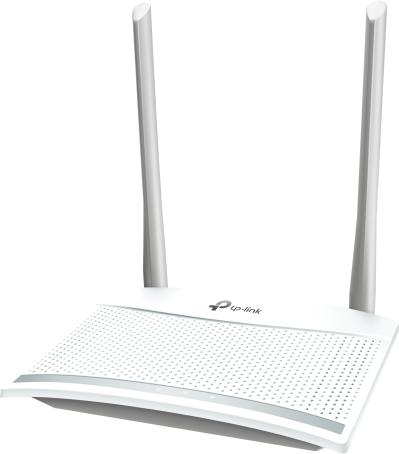
Chapter 1 |
Get to Know About Your Router |
1. 1. Product Overview
The TP-Link router is designed to fully meet the need of Small Office/Home Office (SOHO) networks and users demanding higher networking performance. The powerful antennas ensure continuous Wi-Fi signal to all your devices while boosting widespread coverage throughout your home, and the built-in Ethernet ports supply high-speed connection to your wired devices.
Moreover, it is simple and convenient to set up and use the TP-Link router due to its intuitive web interface.
1. 2. Panel Layout
1. 2. 1. Top Panel
The router’s LEDs are located on the top panel. You can check the router’s working status by following the LED explanation table.
3
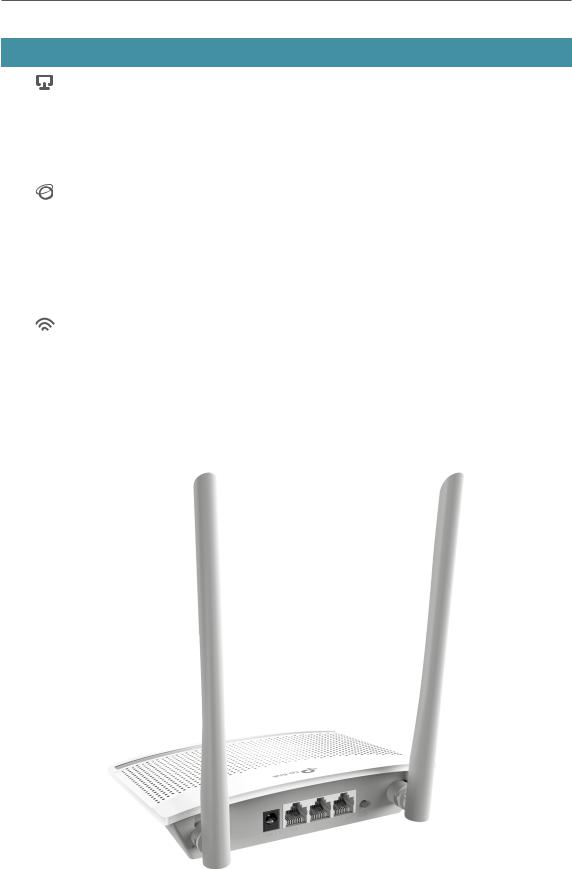
Chapter 1 Get to Know About Your Router
LED |
|
Indication |
|
LAN LED |
Green |
Solid on: At least one LAN port is connected. |
|
|
|
||
|
|
Solid on: |
|
|
Orange |
The WAN port is connected, but internet is not available. |
|
|
Blinking: |
||
|
|
||
Internet LED |
|
The WAN port is not connected. |
|
|
Solid on: |
||
|
Green |
Internet is available. |
|
|
Blinking: |
||
|
|
||
|
|
The system is starting up or firmware is being upgraded*. |
|
|
|
Solid on: |
|
Wi-Fi LED |
Green |
Wireless function is enabled. |
|
Blinking: |
|||
|
|||
|
|
WPS connection is in progress. This may take up to 2 minutes. |
* To avoid device damage, do not disconnect or power off your router during the upgrade.
1. 2. 2. Back Panel
The following parts (view from left to right) are located on the rear panel.
4

Chapter 1 Get to Know About Your Router
Item |
Description |
|
POWER Port |
For connecting the router to a power socket via the provided power adapter. |
|
WAN Port |
For connecting to a DSL/Cable modem, or an Ethernet port. |
|
Ethernet Ports (1, 2) |
For connecting your PCs or other wired network devices to the router. |
|
|
With WPS enabled, press this button for 1 second to start the WPS |
|
|
process. If you have a WPS-supported device, you can press this button to |
|
WPS/RESET Button |
quickly establish connection between the router and the client device and |
|
automatically configure wireless security for your wireless network. |
||
|
Press and hold this button for more than 5 seconds until the Internet LED |
|
|
blinks to reset the router to its factory default settings. |
|
Antennas |
Used for wireless operation and data transmitting. Upright them for the best |
|
Wi-Fi performance. |
||
|
 Note:
Note:
To use the WPS button, please make sure the WPS function is enabled. Please go to Advanced > Wireless > Host network to enable WPS.
5

Chapter 2
Quick Setup
This chapter contains the following sections:
•Position Your Router
•Connect the Hardware
•Set Up the Router

Chapter 2 |
Quick Setup |
2. 1. Position Your Router
•The product should not be located in a place where it will be exposed to moisture or excessive heat.
•Place the router in a location where it can be connected to multiple devices as well as to a power source.
•Make sure the cables and power cord are safely placed out of the way so they do not create a tripping hazard.
•The router can be placed on a shelf or desktop.
•Keep the router away from strong devices with strong electromagnetic interference, such as Bluetooth devices, cordless phones and microwaves.
2. 2. Connect the Hardware
If your internet connection is through an Ethernet cable directly from the wall, instead of through a modem, connect the Ethernet cable to the router’s WAN port, and skip steps 1, 2, and 3 below.
Power adapter |
1 |
2 |
Modem |
|
Router |
Connect to the internet
Connect to the power socket
1.Turn off the modem, and remove the backup battery if it has one.
2.Connect the modem to the router’s WAN port with an Ethernet cable.
3.Turn on the modem, and then wait about 2 minutes for it to restart.
4.Connect the power adapter to the router.
5. Verify that the  LED turns solid on before continuing with the configuration.
LED turns solid on before continuing with the configuration.
7
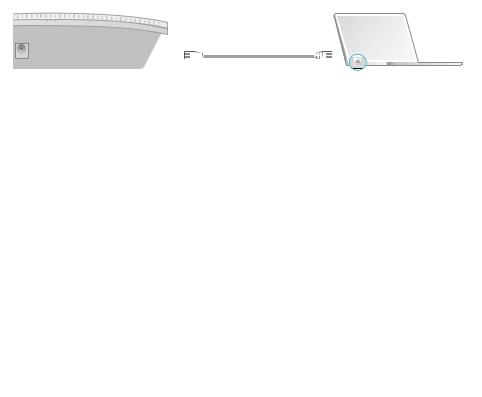
Chapter 2 |
Quick Setup |
2. 3. Set Up the Router
1.Connect your computer to the router.
• Method 1: Wired
Turn off the Wi-Fi on your computer and connect the devices as shown below.
1 |
2 |
Ethernet cable
•Method 2: Wireless
1 ) Find the SSID (Network Name) printed on the label at the bottom of the router.
2 ) Click the network icon of your computer or go to Wi-Fi Settings of your smart device, and then select the SSID to join the network.
|
|
|
|
Computer |
|
|
|
|
|
|
|
|
|
|
|
|
|
Smart Device |
||
|
|
|
|
Connections are available |
|
< Settings |
Wi-Fi |
|||||||||||||
|
|
|
|
|
|
|
|
|
||||||||||||
|
|
|
|
|
|
|
|
|
||||||||||||
|
|
|
|
|
|
|
|
|
||||||||||||
|
|
|
|
|
|
|
|
|
|
|
|
|
|
|
|
|
|
|
|
|
|
|
|
|
|
|
|
|
|
|
|
|
|
|
|
|
|
Wi-Fi |
|
|
|
Wireless Network Connection |
|
|
|
|
|
|
|
|
|
OR |
|
|
|
|||||||
|
|
|
|
|
|
|
|
|
|
|
|
|
|
CHOOSE A NETWORK... |
||||||
TP-Link_XXXX |
|
|
|
|
|
|
|
|
|
|||||||||||
|
|
|
|
|
|
|
|
|||||||||||||
|
|
|
|
|
|
|
|
|
|
|
|
|
|
|
|
|||||
|
|
Connect automatically |
Connect |
TP-Link_XXXX |
|
|
||||||||||||||
|
|
|
||||||||||||||||||
|
|
|
||||||||||||||||||
|
|
|
|
|
|
|
|
|
|
|
|
|
|
|
|
|
Other... |
|
|
|
|
|
|
|
|
|
|
|
|
|
|
|
|
|
|
|
|
|
|
|
|
|
|
|
|
|
|
|
|
|
|
|
|
|
|
|
|
|
|
|
|
|
•Method 3: Use the WPS button
Wireless devices that support WPS, including Android phones, tablets, most USB network cards, can be connected to your router through this method.
 Note:
Note:
•WPS is not supported by iOS devices.
•The WPS function cannot be configured if the wireless function of the router is disabled. Also, the WPS function will be disabled if your wireless encryption is WEP. Please make sure the wireless function is enabled and is configured with the appropriate encryption before configuring the WPS.
•The WPS function cannot work if it is disabled. Please go to Advanced > Wireless > Host network to enable WPS.
1 ) |
Tap the WPS icon on the device’s screen. Here we take an Android phone as an |
|
example. |
2 ) |
Immediately press the WPS button on your router. |
8
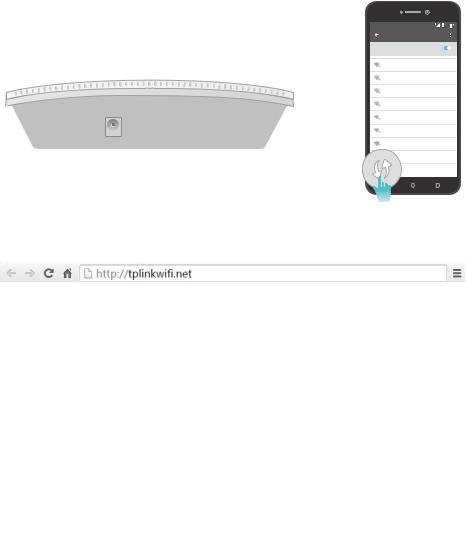
Chapter 2 |
Quick Setup |
Close to
1 2
WLAN
On
TP-Link
HomeNetwork
Office
TP-Link_123
TP-Link_ABC
MyHome
Test
2.Enter http://tplinkwifi.net in the address bar of a web browser. Create a password to log in.
 Note:
Note:
If the login window does not appear, please refer to the FAQ Section.
3.Follow the step-by-step instructions to set up the internet connection.
4.Enjoy! For wireless devices, you may have to reconnect to the wireless network if you have customized the SSID (wireless name) and password during the configuration.
9

Chapter 3
Log In to the Router
This chapter introduces how to log in to the web management page of the router.
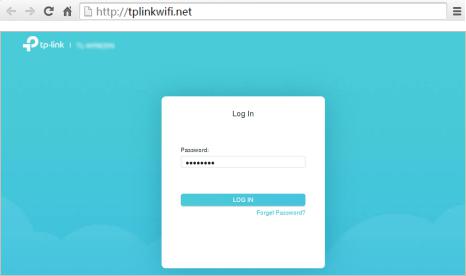
Chapter 3 |
Log In to the Router |
With the web-based utility, it is easy to configure and manage the router. The web-based utility can be used on any Windows, Mac OS or UNIX OS with a web browser, such as Microsoft Internet Explorer, Mozilla Firefox or Apple Safari.
Follow the steps below to log in to your router.
1.Set up the TCP/IP Protocol in Obtain an IP address automatically mode on your computer.
2.Visit http://tplinkwifi.net, and log in with the password you set for the router.
 Note:
Note:
If the login window does not appear, please refer to the FAQ section.
11

Chapter 4
Configure the Router
This chapter presents how to configure the various features of the router. It contains the following sections:
•Device
•Network
•Wireless
•Network Control
•Advanced Users
•System Tools
•Logout
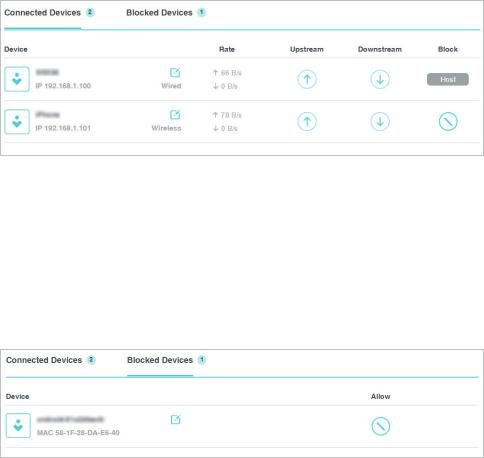
Chapter 4 |
Configure the Router |
4. 1. Device
1.Visit http://tplinkwifi.net, and log in with the password you set for the router.
2.Go to Device to view and manage the connected and blocked devices of the router.
Connected devices:
•Device - Displays the name and IP address of the connected device. You can click  to edit the device name.
to edit the device name.
•Rate - Displays the current upstream and downstream speed of the device.
•Upstream/Downstream - You can click the  /
/ button to limit the upstream or downstream speed for the device.
button to limit the upstream or downstream speed for the device.
•Block - Click  to block the device to access your network.
to block the device to access your network.
Blocked devices:
•Device - Displays the name and MAC address of the blocked device. You can click  to edit the device name.
to edit the device name.
•Allow - Click  to allow the device to access your network.
to allow the device to access your network.
4. 2. Network
4. 2. 1. WAN Settings
1.Visit http://tplinkwifi.net, and log in with the password you set for the router.
2.Go to Network for basic WAN settings, or go to Advanced > Network > WAN Settings for advanced WAN settings.
13
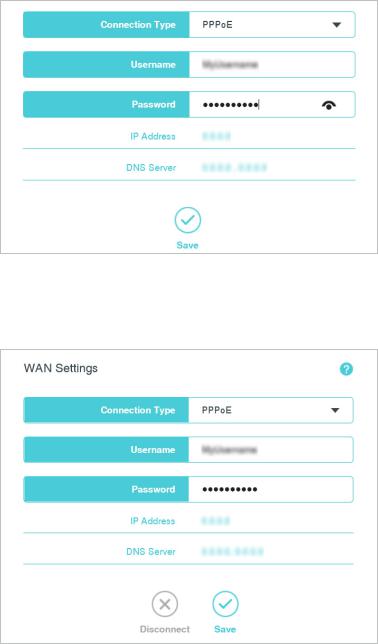
Chapter 4 |
Configure the Router |
3.Select the Connection Type according to your ISP, configure related settings, and click Save.
PPPoE
Select this type if you use DSL (Digital Subscriber Line) service and are provided with a username and password by the ISP.
Basic PPPoE Settings:
•Username/Password - Enter the user name and password provided by your ISP. These fields are case-sensitive.
Advanced PPPoE settings:
Click Disconnect to disconnect the internet immediately.
Click Connect to connect the internet immediately.
14

Chapter 4 |
Configure the Router |
|
|
|
|
|
|
|
•Secondary Connection - If your ISP provides an extra connection type, select Dynamic IP or Static IP to activate the secondary connection.
•Connection Type
•Connect Automatically - In this mode, the internet connection can be reestablished automatically when it is down.
•Connect on Demand - In this mode, the internet connection can be terminated automatically after a specified inactivity period (Max Idle Time) and be reestablished when you attempt to access the internet again. If you want to keep your internet connection active all the time, please enter 0 in the Max Idle Time field. Otherwise, enter the number of minutes you want to have elapsed before your internet access disconnects.
•Connect Manually - You can click Connect/Disconnect to connect/disconnect immediately. This mode also supports the Max Idle Time function as Connect on Demand mode. The internet connection can be disconnected automatically after a specified inactivity period (Max Idle Time) but not be able to re-establish when you attempt to access the internet again.
 Note:
Note:
Sometimes the connection cannot be terminated although you have specified the Max Idle Time because some applications are visiting the internet continually in the background.
15
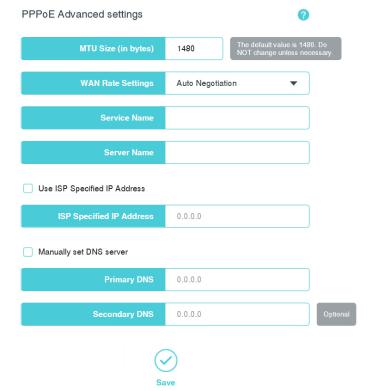
Chapter 4 |
Configure the Router |
|
|
|
|
|
|
|
•MTU Size (in bytes) - The default MTU size is 1480 bytes. Do not change the default MTU size unless required by your ISP.
•WAN Rate Settings - Select the rate and duplex mode for the WAN port. It is recommended to keep the default auto mode.
•Service Name/Server Name - The service name and server name should not be configured unless you are sure it is necessary for your ISP. In most cases, leaving these fields blank will work.
•Use ISP Specified IP Address - If your ISP does not automatically assign IP addresses to the router, select this check box and enter the IP address provided by your ISP in dotted-decimal notation.
•Manually set DNS server - If your ISP provides you one or two DNS addresses, select this check box and enter the primary and secondary DNS addresses into the correct fields. Otherwise, the DNS servers will be assigned automatically from your ISP.
Dynamic IP
Select this type if your ISP provides the DHCP service, and the router will automatically get IP parameters from your ISP.
16
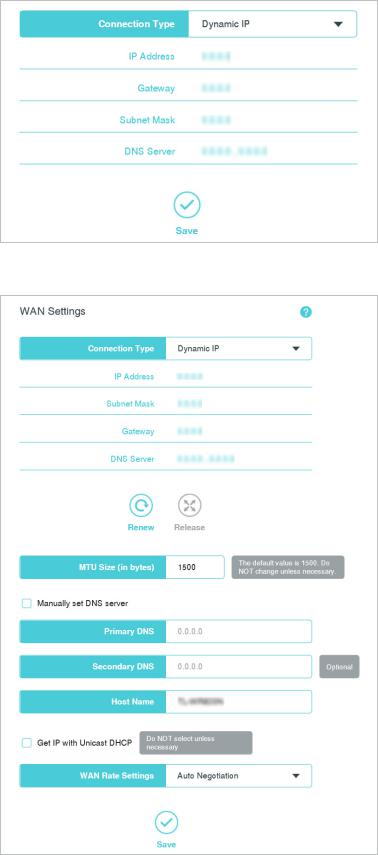
Chapter 4 |
Configure the Router |
Basic Dynamic IP Settings:
Advanced Dynamic IP Settings:
17
